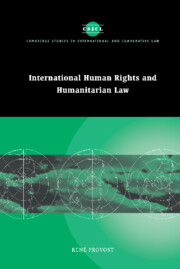Book contents
General conclusion
Published online by Cambridge University Press: 07 September 2009
Summary
Both human rights and humanitarian law are fields which have witnessed change at an accelerated pace in the last decade. The aim of this book has not been to attempt to overlay tidiness and coherence within and between these two fields, but rather to identify some of the forces at work in human rights and humanitarian law to provide a greater comprehension of ongoing transitions. More specifically, given the similarity of their fundamental purpose, the protection of basic interests of the individual, the analysis has sought to assess the closeness of the humanitarian law regime to that of human rights law. Because human rights have permeated every area of international law including, without the slightest possible doubt, humanitarian law, the question arises as to whether the difference between these two fields is mostly semantic and contextual. If there is indeed a specificity to each regime, should it be celebrated and highlighted or deplored and downplayed?
The differences between human rights and humanitarian law go far beyond an acknowledgment that one applies more readily to situations of political stability and the other to times of armed conflict. The vastly distinct power dynamics at work in war and peace have led to opposite conceptualisations of the individual vis-à-vis those wielding power over that individual. Through various institutions of humanitarian law, the main picture of the individual that emerges is that of a person necessarily and dialectically connected to a designated state or group.
- Type
- Chapter
- Information
- International Human Rights and Humanitarian Law , pp. 343 - 350Publisher: Cambridge University PressPrint publication year: 2002

